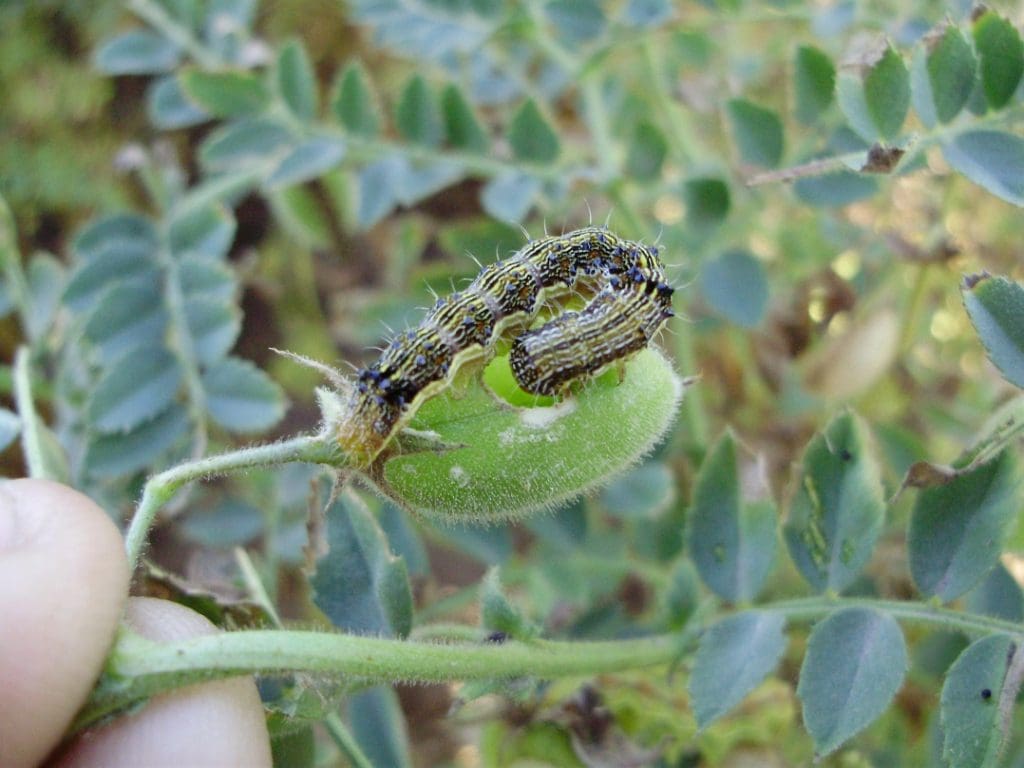
Heliothis (Helicoverpa sp) feeding on a chickpea pod. (Photo: Pulse Australia)
A SIGNIFICANT increase in resistance to one key insecticide used to control the crop pest insect, Helicoverpa, has been recorded in central western New South Wales prompting experts to encourage grain growers and agronomists to use best practice tactics when managing the pest this season.
The latest results from an annual surveillance program undertaken by the NSW Department of Primary Industries (DPI) with support from the Grains Research and Development Corporation (GRDC) and the Cotton Research and Development Corporation (CRDC) found Helicoverpa insecticide resistance levels had risen to historically high levels in the Macquarie Valley region.
Resistance to indoxacarb insecticides was recorded at 17 per cent in the Warren and Narromine areas.
This is the highest figure the surveillance program has ever recorded in NSW and represents a significant increase from 2017-19 data for the valley, which showed resistance levels between two and four per cent.
The results are in marked contrast to the average indoxacarb resistance of 6.8pc measured across major grain production areas in Queensland and NSW in 2020-21. This is down from 8.7pc in 2018-19.
However minor increases in indoxacarb resistance levels were also detected in the Darlings Downs (Queensland), Burdekin (Queensland) and lower Namoi (NSW) regions, which has experts warning industry not to become complacent about best management practices.
Surveillance program
NSW DPI researcher Lisa Bird leads the surveillance program, which monitors Helicoverpa resistance to selective insecticides (indoxacarb, chlorantraniliprole and emamectin benzoate) across the northern grain production areas.
“The program has been developed to provide regionally specific information to assist growers to effectively and sustainably manage Helicoverpa armigera, which is a crop pest in pulses, oilseeds, coarse grains and winter cereals,” Dr Bird said.
“However, the most recent surveillance data for Warren and Narromine in the Macquarie Valley region reveals a critical need to strategically manage the threat of resistance to maintain the efficacy of pivotal insecticides.”
She said although elevated indoxacarb resistance has been previously reported in the Burdekin region of north Queensland, it has not been observed in NSW at such a high rate until this year.
“It is unclear why there has been such a marked increase in the Macquarie region, which was previously considered lower risk for resistance due to a shorter growing season and few generations of exposure to insecticides compared with more northern growing regions in central and northern Queensland,” Dr Bird said.
“While the 2020-21 data also showed increased indoxacarb levels in samples from the Darling Downs and lower Namoi, this could be due to seasonal variation rather than a concerning trend.”
As a result of the surveillance findings further sampling in areas identified as having high risk for resistance would now be undertaken as a key priority this season.
“It will be important to monitor the situation carefully to determine whether moths that will potentially establish in winter pulses are carrying genes for indoxacarb resistance,” Dr Bird said.
“This will assist growers in considering their best options for maximising the cost of control.”
Burdekin tops Qld levels
In Queensland the 2020-21 surveillance data revealed indoxacarb resistance levels of 11pc in the Burdekin. These were the highest levels recorded in the state.
“This finding is consistent with trends in previous years where we found elevated resistance status in the Burdekin region compared with other areas in Queensland,” Dr Bird said.
“Although it’s important to note the level of the resistance in the Burdekin had declined from 2018-19 when levels peaked at 17 per cent.”
This pattern of decline is consistent with similar falling rates of indoxacarb resistance in key production areas of central Queensland since levels peaked in 2018-19.
“Generally, across all regions surveyed there was a pattern of very low emamectin benzoate resistance. Resistance to chlorantraniliprole also remains low,” Dr Bird said.
“This is a positive sign that these insecticidal groups will remain effective against Helicoverpa in key grains areas, like central Queensland, where insecticide use is likely to increase on the back of recent rainfall and anticipated plantings of winter pulses.”
Reduce the risk
Dr Bird said to reduce the risk of insecticide resistance growers and agronomists were being encouraged to follow the Helicoverpa resistance management strategy available on the GRDC website.
Tips to minimise resistance development:
- Comply with product label directions
- Avoid repeated use of insecticides from the same group.
- If a spray fails due do not re-spray in the same season using a product from the same group.
- Where possible, use target-specific ‘soft’ chemicals rather than broad-spectrum pesticides.
- Correctly identify the pest to ensure the most effective insecticide and rate is use.
- Monitor beneficial populations to determine if chemical control of Helicoverpa is warranted.
- Ensure spray rigs are calibrated properly and nozzles are selected to achieve good coverage.
- Monitor paddocks for evidence of loss of field efficacy and report field failures. Field failures should be reported to Lisa Bird at [email protected]
Source: GRDC

HAVE YOUR SAY